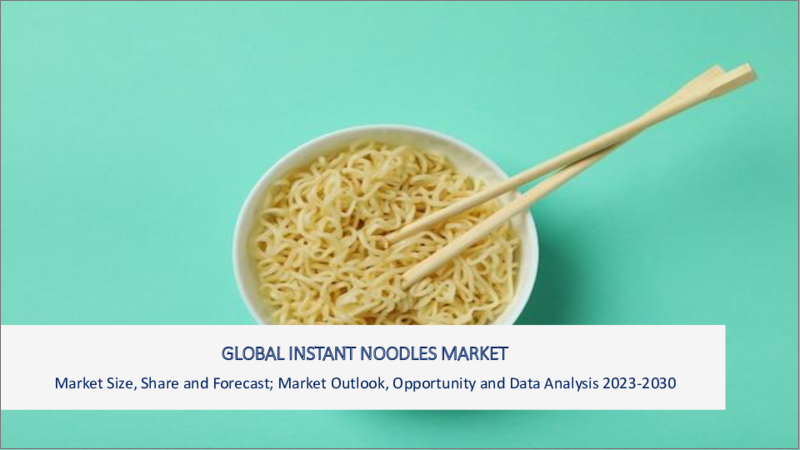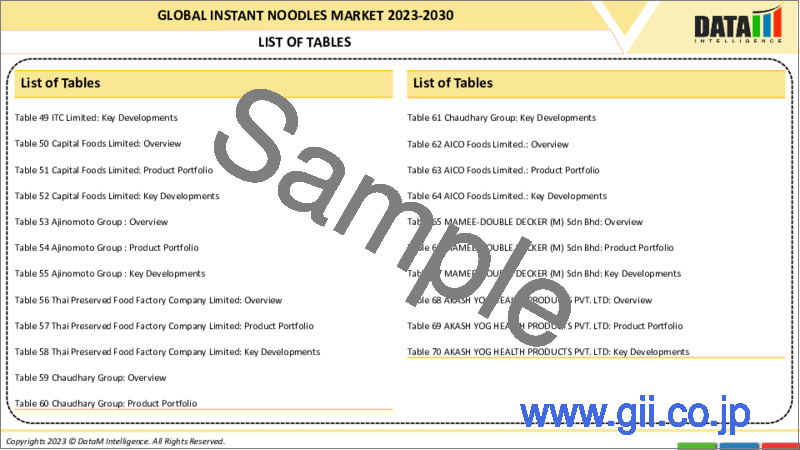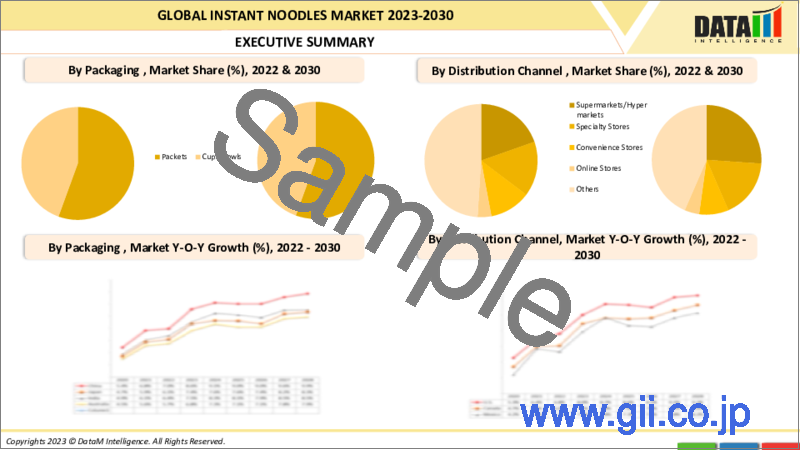|
|
市場調査レポート
商品コード
1289785
インスタントラーメンの世界市場- 2023-2030Global Instant Noodles Market - 2023-2030 |
||||||
|
● お客様のご希望に応じて、既存データの加工や未掲載情報(例:国別セグメント)の追加などの対応が可能です。 詳細はお問い合わせください。 |
|||||||
| インスタントラーメンの世界市場- 2023-2030 |
|
出版日: 2023年06月12日
発行: DataM Intelligence
ページ情報: 英文 200 Pages
納期: 約2営業日
|
- 全表示
- 概要
- 目次
市場概要
インスタントラーメンの世界市場規模は、2022年に425億米ドル、2030年には662億米ドルに達し、有利な成長を遂げると予測されています。2023年から2030年の予測期間中、市場は5.7%のCAGRで成長する見通しです。
インスタントラーメンは、主に精製小麦粉と様々なアルカリ塩で作られています。生地に少ない割合で加えられるその他の成分には、小麦粉、食用油、グルテン、グアーガムなどの安定剤などがあります。インスタントラーメンは、あらかじめ調理された乾燥麺で、脱水する前にフラッシュフライや空炒めしたものです。テーストメーカーを含む小さな小袋が付属していることが多いです。
インスタントラーメンは、持ち運びができ、調理が簡単で、保存がきくため、世界中でますます好まれるようになってきています。ミレニアル世代の人口の拡大と労働者階級の顧客の増加が、インスタントラーメンのようなパッケージ食品の需要を牽引しています。
市場力学
利便性の向上と手頃な価格がインスタントラーメン市場の成長を促進する
都市化の進展に伴い、人々は以前にも増して多忙なライフスタイルを送っています。米国労働統計局によると、平均的な米国人は1日に8時間以上を仕事や仕事関連の活動に費やしています。そのため、料理をする時間はほとんどなく、インスタントラーメンは手軽で便利な食事ソリューションとなっています。インスタントラーメンは、他の食事の選択肢に比べ、比較的安価です。
例えば、英国のGuardian紙の調査によると、インスタントラーメン1パックの価格は約30ペソ、サンドイッチは約2.00ポンドであることがわかりました。そのため、インスタントラーメンは、予算が限られている人々にとって手頃な食事の選択肢となっています。
フレーバーと品種のイノベーションの増加がインスタントラーメン市場を活性化させると予想される
インスタントラーメン市場にとって、フレーバーや品種の革新が進むことは大きなチャンスであり、メーカーが消費者の多様な味の好みに対応できるようになるからです。新しくエキサイティングなフレーバーや品種のイントロダクションは、インスタントラーメンの魅力を高め、新規顧客の獲得と既存顧客の維持に貢献しています。
例えば、インドでは、インスタントラーメンメーカーがマサラ、トマト、チキンなどのフレーバーを発売し、消費者の間で非常に人気があります。フレーバーや品種の革新により、メーカーは競合他社との差別化を図ることができ、市場での競争力を高めることができます。
COVID-19の影響分析
COVID-19の分析では、COVID前シナリオ、COVIDシナリオ、COVID後シナリオに加え、価格力学(COVID前シナリオと比較したパンデミック中・後の価格変動を含む)、需要-供給スペクトラム(取引制限、封鎖、その後の問題による需要と供給のシフト)、政府の取り組み(政府機関による市場、セクター、産業の活性化に関する取り組み)、メーカー戦略的取り組み(COVID問題を軽減するためにメーカーは何を行ったのかを紹介します)。
ロシア・ウクライナ戦争による影響
今回の危機により、ロシアとウクライナの両国でインスタントラーメンメーカーの製造とサプライチェーンが寸断されました。ロシア連邦国家統計局によると、COVID-19の流行と経済制裁により、インスタントラーメンの製造に必要な原材料や設備の輸入に影響が出ました。
このため、2020年のロシアにおける食品生産量は0.4%減少しました。世界貿易機関によると、ウクライナからロシアへの食品の輸出は、紛争の影響もあり、2013年から2019年にかけて52%減少しました。
目次
第1章 調査手法と範囲
- 調査手法
- 調査目的および調査範囲
第2章 定義と概要
第3章 エグゼクティブサマリー
第4章 市場力学
- 影響要因
- 促進要因
- コンビニエンスフードの普及
- 利便性の向上と手頃な価格
- 抑制要因
- 肥満と糖尿病の蔓延
- 機会
- フレーバーと品種のイノベーションの増加
- 影響分析
- 促進要因
第5章 産業分析
- ポーターのファイブフォース分析
- サプライチェーン分析
- 価格分析
- 法規制の分析
第6章 COVID-19の分析
第7章 製品タイプ別
- ベジタブル
- 鶏肉
- シーフード
- その他
第8章 原材料別
- 小麦
- 米
- オーツ麦
- その他
第9章 パッケージ別
- パケット
- カップ・ボウル
第10章 流通チャネル別
- スーパーマーケット/ハイパーマーケット
- 専門店
- コンビニエンスストア
- オンライン販売
- その他
第11章 地域別
- 北米
- 米国
- カナダ
- メキシコ
- 欧州
- ドイツ
- 英国
- フランス
- イタリア
- スペイン
- その他欧州
- 南米
- ブラジル
- アルゼンチン
- その他南米地域
- アジア太平洋地域
- 中国
- インド
- 日本
- オーストラリア
- その他アジア太平洋地域
- 中東・アフリカ地域
第12章 競合情勢
- 競合シナリオ
- 市況/シェア分析
- M&A(合併・買収)分析
第13章 企業プロファイル
- Nissin Food Holdings
- 会社概要
- 製品ポートフォリオと説明
- 財務概要
- 主な発展状況
- Nestle S.A.
- ITC Limited
- Capital Foods Pvt Ltd.
- Ajinomoto Co. Inc.
- Thai Preserved Food Factory Co.Ltd
- CG Foods India Pvt. Ltd.
- GSK Consumer Healthcare(India)Ltd.
- Inbisco India Pvt. Ltd.
- Aico Food Ltd.
第14章 付録
Market Overview
The Global Instant Noodles Market size US$ 42.5 billion in 2022 and is projected to witness lucrative growth by reaching up to US$ 66.2 billion by 2030. The market is growing at a CAGR of 5.7% during the forecast period 2023-2030.
Instant noodles are primarily made of refined wheat flour and a variety of alkaline salts. Other ingredients that are added to the dough in smaller proportions include flour, edible oil, gluten, and stabilizers such as guar gum. Instant noodles are precooked, dried noodles that have been flash-fried or fried in the air before being dehydrated. They often include a little sachet that contains the tastemaker.
Instant Noodles are becoming more and more well-liked all around the world because they are portable, quick to cook, and simple to keep. An expanding millennial population and an increase in working-class customers are driving demand for packaged food products like instant noodles.
Market Dynamics
Rising Convenience and Affordability are Anticipated to Grow the Instant Noodles Market's Growth
With the increase in urbanization, people are leading busier lifestyles than ever before. According to the US Bureau of Labor Statistics, the average American spends over 8 hours a day at work or on work-related activities. This leaves little time for cooking, and instant noodles provide a quick and convenient meal solution. Instant noodles are relatively inexpensive compared to other meal options.
For example, a study by the UK's Guardian newspaper found that a packet of instant noodles costs around 30p, while a sandwich costs around £2.00. This makes instant noodles an affordable meal option for people on a tight budget.
Increasing Innovation in Flavors and Varieties is Expected to Fuel the Instant Noodles Market
Increasing innovation in flavors and varieties is a significant opportunity for the instant noodles market, as it allows manufacturers to cater to the diverse taste preferences of consumers. The introduction of new and exciting flavors and varieties has increased the appeal of instant noodles, attracting new customers and retaining existing ones.
For instance, in India, instant noodles manufacturers have introduced flavors such as masala, tomato and chicken, which have become extremely popular among consumers. Innovation in flavors and varieties allows manufacturers to differentiate their products from competitors, giving them a competitive edge in the market.
COVID-19 Impact Analysis
The COVID-19 Analysis includes Pre-COVID Scenario, COVID Scenario, and Post-COVID Scenario along with Pricing Dynamics (Including pricing change during and post-pandemic comparing it to pre-COVID scenarios), Demand-Supply Spectrum (Shift in demand and supply owing to trading restrictions, lockdown and subsequent issues), Government Initiatives (Initiatives to revive market, sector or Industry by Government Bodies) and Manufacturers Strategic Initiatives (What manufacturers did to mitigate the COVID issues will be covered here).
Russia-Ukraine War Impact
The crisis has caused manufacturing and the supply chain for the producers of instant noodles in both Russia and Ukraine to be disrupted. According to the Russian Federal State Statistics Service, the COVID-19 pandemic and economic sanctions affected the import of raw materials and equipment required for the production of instant noodles.
This caused a 0.4% decline in food product output in Russia in 2020. According to the World Trade Organization, exports of food products from Ukraine to Russia decreased by 52% between 2013 and 2019, due in part to the conflict.
Segment Analysis
The global instant noodles market is segmented based on product type, raw material, packaging, distribution channel and region.
By Raw Material, the Wheat Segment Holds the Largest Market Share of the Instant Noodles Market
Wheat flour is widely available and cost-effective, making it the preferred ingredient in instant noodles manufacturing. Wheat flour provides the desired texture and taste to instant noodles, giving them the distinctive chewy and springy texture that consumers enjoy.
According to the Food and Agriculture Organization of the United Nations, wheat is the most widely grown crop in the world and is the primary source of calories for over 1 billion people. This indicates the widespread availability and popularity of wheat as a staple food, which contributes to the large market share of the wheat segment in the instant noodles market.
Geographical Analysis
North America is the Fastest-growing Market in the Instant Noodles Industry
The instant noodles market in North America has been growing steadily in recent years, driven by changing consumer preferences and increasing demand for convenience foods. As people's lives become increasingly busy, they are looking for quick and convenient meal solutions. Instant noodles offer a quick and easy meal option that can be prepared in minutes.
According to World Instant Noodles Association, the demand for noodles in the United States of America has increased from 4,130 million servings in 2017 to 4,980 million servings in 2021.
Competitive Landscape
The major global players include: the Instant Noodles market are Nissin Food Holdings, Nestle S.A., ITC Limited, Capital Foods Pvt Ltd., Ajinomoto Co. Inc., Thai Preserved Food Factory Co. Ltd, CG Foods India Pvt. Ltd., GSK Consumer Healthcare (India) Ltd., Inbisco India Pvt. Ltd., and Aico Food Ltd.
Why Purchase the Report?
- To visualize the global instant noodles market segmentation based on product type, raw material, packaging and distribution channel to understand key commercial assets and players.
- Identify commercial opportunities by analyzing trends and co-development.
- Excel data sheet with numerous data points of instant noodles market-level with all segments.
- PDF report consists of a comprehensive analysis after exhaustive qualitative interviews and an in-depth study.
- Product mapping available as Excel consisting of key products of all the major players.
The Global Instant Noodles Market Report Would Provide Approximately 69 Tables, 69 Figures and 200 pages.
Target Audience 2023
- Manufacturers / Buyers
- Industry Investors/Investment Bankers
- Research Professionals
- Emerging Companies
Table of Contents
1. Methodology and Scope
- 1.1. Research Methodology
- 1.2. Research Objective and Scope of the Report
2. Definition and Overview
3. Executive Summary
- 3.1. Snippet by Product Type
- 3.2. Snippet by Raw Material
- 3.3. Snippet by Packaging
- 3.4. Snippet by Distribution Channel
- 3.5. Snippet by Region
4. Dynamics
- 4.1. Impacting Factors
- 4.1.1. Drivers
- 4.1.1.1. Growing adoption of convenient foods
- 4.1.1.2. Rising Convenience and Affordability
- 4.1.2. Restraints
- 4.1.2.1. Increasing prevalence of obesity and diabetes
- 4.1.3. Opportunity
- 4.1.3.1. Increasing innovation in flavors and varieties
- 4.1.4. Impact Analysis
- 4.1.1. Drivers
5. Industry Analysis
- 5.1. Porter's Five Force Analysis
- 5.2. Supply Chain Analysis
- 5.3. Pricing Analysis
- 5.4. Regulatory Analysis
6. COVID-19 Analysis
- 6.1. Analysis of COVID-19
- 6.1.1. Scenario Before COVID-19
- 6.1.2. Scenario During COVID-19
- 6.1.3. Scenario Post COVID-19
- 6.2. Pricing Dynamics Amid COVID-19
- 6.3. Demand-Supply Spectrum
- 6.4. Government Initiatives Related to the Market During the Pandemic
- 6.5. Manufacturers' Strategic Initiatives
- 6.6. Conclusion
7. By Product Type
- 7.1. Introduction
- 7.1.1. Market Size Analysis and Y-o-Y Growth Analysis (%), By Product Type
- 7.1.2. Market Attractiveness Index, By Product Type
- 7.2. Vegetable*
- 7.2.1. Introduction
- 7.2.2. Market Size Analysis and Y-o-Y Growth Analysis (%)
- 7.3. Chicken
- 7.4. Sea Food
- 7.5. Others
8. By Raw Material
- 8.1. Introduction
- 8.1.1. Market Size Analysis and Y-o-Y Growth Analysis (%), By Raw Material
- 8.1.2. Market Attractiveness Index, By Raw Material
- 8.2. Wheat*
- 8.2.1. Introduction
- 8.2.2. Market Size Analysis and Y-o-Y Growth Analysis (%)
- 8.3. Rice
- 8.4. Oats
- 8.5. Others
9. By Packaging
- 9.1. Introduction
- 9.1.1. Market Size Analysis and Y-o-Y Growth Analysis (%), By Packaging
- 9.1.2. Market Attractiveness Index, By Packaging
- 9.2. Packets*
- 9.2.1. Introduction
- 9.2.2. Market Size Analysis and Y-o-Y Growth Analysis (%)
- 9.3. Cups/Bowls
10. By Distribution Channel
- 10.1. Introduction
- 10.1.1. Market Size Analysis and Y-o-Y Growth Analysis (%), By Distribution Channel
- 10.1.2. Market Attractiveness Index, By Distribution Channel
- 10.2. Supermarkets/Hypermarkets *
- 10.2.1. Introduction
- 10.2.2. Market Size Analysis and Y-o-Y Growth Analysis (%)
- 10.3. Specialty Stores
- 10.4. Convenience Stores
- 10.5. Online Sales
- 10.6. Others
11. By Region
- 11.1. Introduction
- 11.1.1. Market Size Analysis and Y-o-Y Growth Analysis (%), By Region
- 11.1.2. Market Attractiveness Index, By Region
- 11.2. North America
- 11.2.1. Introduction
- 11.2.2. Key Region-Specific Dynamics
- 11.2.3. Market Size Analysis and Y-o-Y Growth Analysis (%), By Product Type
- 11.2.4. Market Size Analysis and Y-o-Y Growth Analysis (%), By Raw Material
- 11.2.5. Market Size Analysis and Y-o-Y Growth Analysis (%), By Packaging
- 11.2.6. Market Size Analysis and Y-o-Y Growth Analysis (%), By Distribution Channel
- 11.2.7. Market Size Analysis and Y-o-Y Growth Analysis (%), By Country
- 11.2.7.1. The U.S.
- 11.2.7.2. Canada
- 11.2.7.3. Mexico
- 11.3. Europe
- 11.3.1. Introduction
- 11.3.2. Key Region-Specific Dynamics
- 11.3.3. Market Size Analysis and Y-o-Y Growth Analysis (%), By Product Type
- 11.3.4. Market Size Analysis and Y-o-Y Growth Analysis (%), By Raw Material
- 11.3.5. Market Size Analysis and Y-o-Y Growth Analysis (%), By Packaging
- 11.3.6. Market Size Analysis and Y-o-Y Growth Analysis (%), By Country
- 11.3.6.1. Germany
- 11.3.6.2. The UK
- 11.3.6.3. France
- 11.3.6.4. Italy
- 11.3.6.5. Spain
- 11.3.6.6. Rest of Europe
- 11.4. South America
- 11.4.1. Introduction
- 11.4.2. Key Region-Specific Dynamics
- 11.4.3. Market Size Analysis and Y-o-Y Growth Analysis (%), By Product Type
- 11.4.4. Market Size Analysis and Y-o-Y Growth Analysis (%), By Raw Material
- 11.4.5. Market Size Analysis and Y-o-Y Growth Analysis (%), By Packaging
- 11.4.6. Market Size Analysis and Y-o-Y Growth Analysis (%), By Distribution Channel
- 11.4.7. Market Size Analysis and Y-o-Y Growth Analysis (%), By Country
- 11.4.7.1. Brazil
- 11.4.7.2. Argentina
- 11.4.7.3. Rest of South America
- 11.5. Asia-Pacific
- 11.5.1. Introduction
- 11.5.2. Key Region-Specific Dynamics
- 11.5.3. Market Size Analysis and Y-o-Y Growth Analysis (%), By Product Type
- 11.5.4. Market Size Analysis and Y-o-Y Growth Analysis (%), By Raw Material
- 11.5.5. Market Size Analysis and Y-o-Y Growth Analysis (%), By Packaging
- 11.5.6. Market Size Analysis and Y-o-Y Growth Analysis (%), By Distribution Channel
- 11.5.7. Market Size Analysis and Y-o-Y Growth Analysis (%), By Country
- 11.5.7.1. China
- 11.5.7.2. India
- 11.5.7.3. Japan
- 11.5.7.4. Australia
- 11.5.7.5. Rest of Asia-Pacific
- 11.6. Middle East and Africa
- 11.6.1. Introduction
- 11.6.2. Key Region-Specific Dynamics
- 11.6.3. Market Size Analysis and Y-o-Y Growth Analysis (%), By Product Type
- 11.6.4. Market Size Analysis and Y-o-Y Growth Analysis (%), By Raw Material
- 11.6.5. Market Size Analysis and Y-o-Y Growth Analysis (%), By Packaging
- 11.6.6. Market Size Analysis and Y-o-Y Growth Analysis (%), By Distribution Channel
12. Competitive Landscape
- 12.1. Competitive Scenario
- 12.2. Market Positioning/Share Analysis
- 12.3. Mergers and Acquisitions Analysis
13. Company Profiles
- 13.1. Nissin Food Holdings*
- 13.1.1. Company Overview
- 13.1.2. Product Portfolio and Description
- 13.1.3. Financial Overview
- 13.1.4. Key Developments
- 13.2. Nestle S.A.
- 13.3. ITC Limited
- 13.4. Capital Foods Pvt Ltd.
- 13.5. Ajinomoto Co. Inc.
- 13.6. Thai Preserved Food Factory Co.Ltd
- 13.7. CG Foods India Pvt. Ltd.
- 13.8. GSK Consumer Healthcare (India) Ltd.
- 13.9. Inbisco India Pvt. Ltd.
- 13.10. Aico Food Ltd.
LIST NOT EXHAUSTIVE
14. Appendix
- 14.1. About Us and Services
- 14.2. Contact Us




